[WLT Note: Low energy Bluetooth audio is an important development direction for the future of Bluetooth audio, which will have a significant impact on the Bluetooth audio market and expand more differentiated application scenarios. Independent low energy Bluetooth audio still has a considerable transition period, where dual-mode Bluetooth plays an important leading role. We will continue to pay attention to the development trends of Bluetooth audio and leverage our long-standing advantages in dual-mode Bluetooth to provide differentiated and valuable services to our customers.]
Since its inception, audio has been the largest solution area for Bluetooth technology. Initially, Bluetooth audio technology was widely used in hands-free phones and wireless headsets. After continuous development, it began to support higher quality audio use cases, especially those supported by the Advanced Audio Distribution Profile (A2DP), such as mobile phones, headsets, and speaker transmissions. Today, Bluetooth audio has been adopted by all smartphones, tablets, and personal computers, as well as billions of wireless headsets and speakers. These use cases generally utilize Classic Bluetooth technology, specifically Bluetooth Basic Rate/Enhanced Data Rate (BR/EDR).
In the past decade, various new audio use cases and requirements have emerged, such as true wireless stereo (TWS) earbud headphones, hearing aids, and connected speakers. However, Classic Bluetooth audio has certain limitations, such as audio quality, power consumption, lack of support for synchronized connections, unidirectional transmission, and issues with switching between audio and voice applications. The advantages and limitations of Classic Bluetooth audio and A2DP lie in the fact that they are both designed as point-to-point technologies.
In 2014, the European Hearing Instrument Manufacturers Association (EHIMA) and the Bluetooth Special Interest Group (SIG) established new standards for hearing aids. This move aimed to enable hearing device users to receive high-quality voice and media audio directly on their devices via Bluetooth technology without needing to purchase additional accessories, allowing interoperability with any brand that uses this technology. After these initial developments, it quickly became clear that developing a new audio standard could also bring significant benefits to the entire consumer audio market and address many limitations of Classic Bluetooth audio. This standard later evolved into the largest specification project in Bluetooth technology history—Low Energy Audio (LE Audio).
The arrival of low energy audio will change the Bluetooth audio ecosystem in the next five to ten years. As the name suggests, low energy audio does not use Classic Bluetooth radio but operates on low energy Bluetooth radio. This is thanks to many new features added in Bluetooth Core Specification version 5.2. These features help improve audio quality, reduce power consumption, enhance interoperability, simplify the development of hearing aids and true wireless stereo earbuds, and support new types of audio devices as well as the emergence of Auracast™ broadcast audio, particularly bringing shared and private broadcast use cases for consumers and hearing applications.
Bluetooth Audio Market Forecast
The following Figure 1 shows ABI Research’s market forecast for Bluetooth audio peripherals over the next five years. This forecast includes devices primarily designed for receiving audio, such as true wireless stereo earbuds, over-ear headphones, speakers, and hearing aids. ABI Research predicts that by 2027, annual shipments of Bluetooth audio peripherals will approach 1.5 billion, including over 730 million true wireless stereo earbuds, 208 million voice-controlled front ends, 192 million speakers, and 179 million hearing aids. These devices will account for 94% of the market.
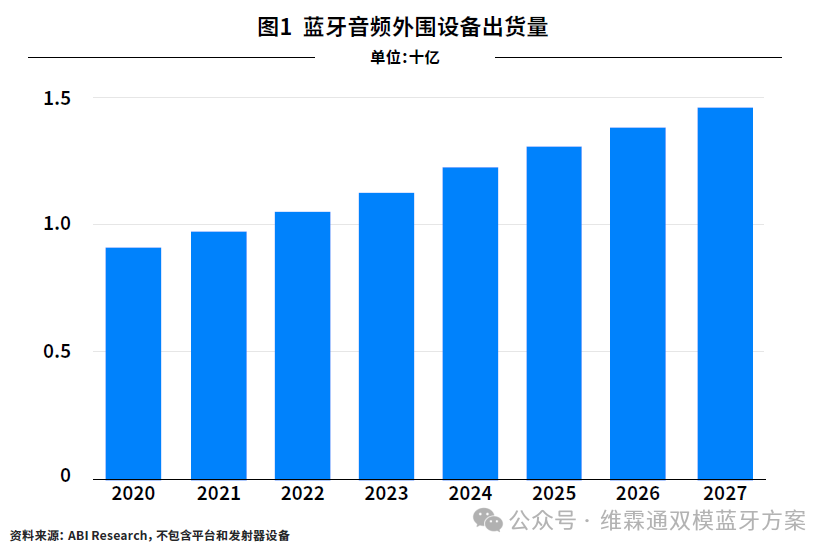
Dual-Mode Bluetooth Audio Will Lead the Trend
Figure 2 shows Bluetooth audio peripherals segmented by different Bluetooth radio technologies. While Classic Bluetooth technology has long dominated the market, in recent years, many audio device manufacturers have begun to adopt dual-mode solutions that combine Classic Bluetooth with low energy Bluetooth. Classic Bluetooth is generally used for audio transmission, while low energy Bluetooth can be used for quick pairing, media control, and enabling tracking earbud location features. Currently, most leading Bluetooth wireless chipset manufacturers provide dual-mode radio solutions (i.e., Classic Bluetooth + low energy Bluetooth) in their audio products. Over time, these dual-mode radio solutions will increasingly support low energy audio features and become dual-mode audio solutions (i.e., Classic audio + low energy audio). This will help generate new Auracast™ broadcast audio use cases, allowing manufacturers to continue to innovate their products by adding features and differentiated performance.
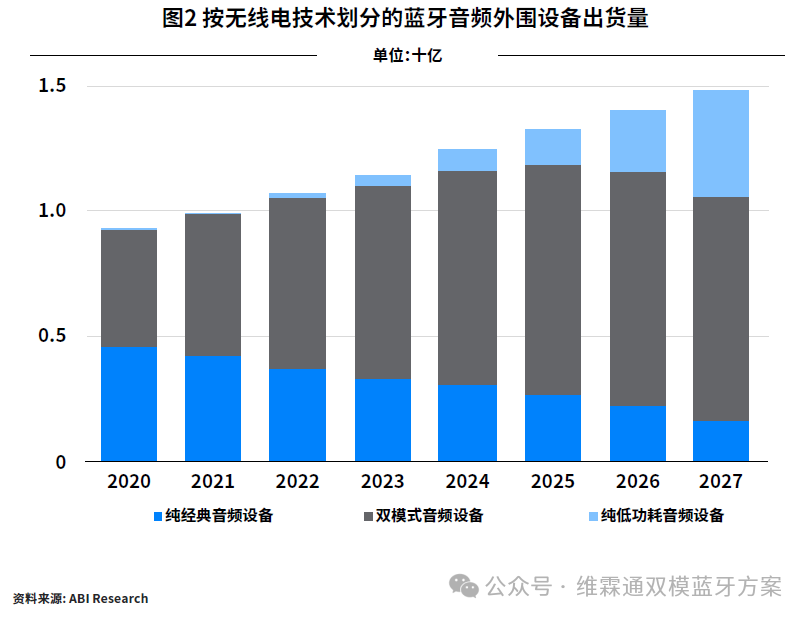
Additionally, this dual-mode strategy will help these leading manufacturers maintain their market advantage during the transition of audio source devices to low energy audio. Existing manufacturers should not fully commit to single-mode low energy audio solutions and limit their target market to those supporting low energy audio source devices until most audio source devices transition to supporting low energy audio. At the same time, when used with audio source devices or public transmitters that support low energy audio, dual-mode solutions can enable new Auracast™ broadcast audio features. Therefore, as shown in Figure 2, dual-mode audio devices are expected to hold the largest share in the Bluetooth audio market throughout the forecast period.
Independent Low Energy Audio Will Gradually Rise
ABI Research also expects a third category of devices—pure low energy audio devices—to emerge. These devices will fully leverage the new low energy audio features and have advantages in power consumption, cost, and more. Some Bluetooth chipset manufacturers emerged only after the advent of low energy Bluetooth, and they neither have Classic Bluetooth audio products nor hold a significant market share in the audio market. These manufacturers can seize new opportunities to gain a foothold in the low energy audio field and establish new advantages. They have minimal market share to lose, allowing them to target new opportunities in the growing hearing aids, true wireless, and broadcast audio markets.
One of the most successful aspects of low energy audio is that it opens the door for newcomers to enter the audio market, making it easier for them to develop cost-effective and less complex non-proprietary products. These products offer better synchronization, lower latency and power consumption, and can enable new features, such as Auracast™ broadcast audio and hearing use cases in public places. Additionally, some existing manufacturers may offer standalone pure low energy audio solutions while providing dual-mode solutions. However, as shown in Figure 2, low energy audio single-mode devices may not become significantly attractive until after 2025, as these devices will need to rely on a large number of audio source devices with low energy audio capabilities.
Leveraging the Power of Ecosystems
Furthermore, low energy audio can be promoted by leveraging the power of ecosystems. Companies operating at both ends of the audio source and sink ecosystem can bundle pure low energy audio sink solutions with new smartphones, tablets, personal computers, smartwatches, or other audio source devices. This way, original equipment manufacturers can help differentiate their audio source products by implementing new broadcast use cases (such as personal audio sharing) and help differentiate sink devices by implementing Auracast™ broadcast audio features, reducing power consumption, shrinking form factors, and improving audio quality. This will ensure that users can connect to low energy audio sources and provide a unique low energy audio experience to users before it becomes widespread in other industries.
Various Strategic Approaches to Transition to Low Energy Audio
ABI Research believes that low energy audio will bring different strategies and approaches depending on manufacturers’ history in the audio market, their existing audio product portfolios, and their positions within the audio ecosystem. Chipset manufacturers active in the smartphone space can adopt a holistic strategy, such as incorporating radio innovations that support low energy audio. With low energy audio, new manufacturers will also have the opportunity to enter this field and create new differentiation.
Some manufacturers may add low energy audio to their dual-mode solutions for Auracast™ broadcast audio features. Others may continue using dual-mode until the installation numbers of low energy audio devices become sufficient before switching to pure low energy audio solutions. Companies without Classic Bluetooth products or market share may dive into low energy audio solutions from the outset. Other companies can distinguish themselves by bundling pure low energy audio headsets with smartphones that support low energy audio, gaining market share through the empowerment of other original equipment manufacturers.
Hearing aid manufacturers will use pure low energy audio solutions to reduce power consumption. Additionally, several existing dual-mode products in the market have announced plans to support new low energy audio features through wireless upgrades. Therefore, it is unlikely that there will be a synchronized transition across all device types.
Low energy audio may ultimately integrate into the existing Bluetooth audio market, becoming part of the innovation across the entire audio field in the next five to ten years, rather than transitioning statically to pure low energy audio devices. There may be a “unity in diversity” between Bluetooth low energy audio and Classic audio, with devices achieving differentiation in various aspects such as use cases, audio quality, latency, power consumption, size, and cost.
Building the Low Energy Bluetooth Audio Ecosystem
The low energy audio ecosystem is largely still in its initial development stage. However, various chipset, IP, and product announcements indicate that a strong low energy audio ecosystem will emerge within the next 12-18 months. As of early September 2022, 103 Bluetooth products support the LC3 codec, and this number continues to grow. These products include various over-ear headphones, in-ear headphones, soundbars, speakers, audio transmitters, smartphones, tablets, and more, as well as chipsets and modules.
ABI Research predicts that by 2027, annual shipments of low energy audio source and sink devices will reach 3 billion. As shown in Figure 3, of the 3 billion low energy audio devices shipped in 2027, it is expected that 86% of these devices will support dual-mode Bluetooth audio. In the foreseeable future, audio source devices will continue to support both Bluetooth Classic audio and low energy audio through dual-mode chipsets.
This will allow these devices to utilize emerging low energy audio and Auracast™ broadcast audio use cases while ensuring compatibility with the existing Bluetooth Classic audio device ecosystem. As the installation numbers of low energy audio devices continue to increase, more and more sink devices will support standalone low energy audio solutions.
Figure 4 shows the forecast for low energy audio device shipments segmented by market. Audio source devices such as smartphones, tablets, personal computers, and TVs, as well as sink devices like true wireless stereo earbuds, over-ear headphones, and hearing aids, are likely to become the first major device categories to adopt low energy audio. Audio source devices will soon embed Bluetooth Core Specification versions 5.2 and above on their platforms, with many audio source solutions embedding versions 5.2 and 5.3 already appearing in the market. In terms of sink devices, manufacturers like Nordic Semiconductor, Realtek, Telink Semiconductor, CEC Huajun, and Hengxuan Technology have also released their respective low energy audio products. Other product categories such as TVs, smartwatches, speakers, and voice-controlled front ends may follow this initial wave of adoption. In the long term, smart home and IoT products will also trend towards innovative interactions through embedding low energy audio technology.
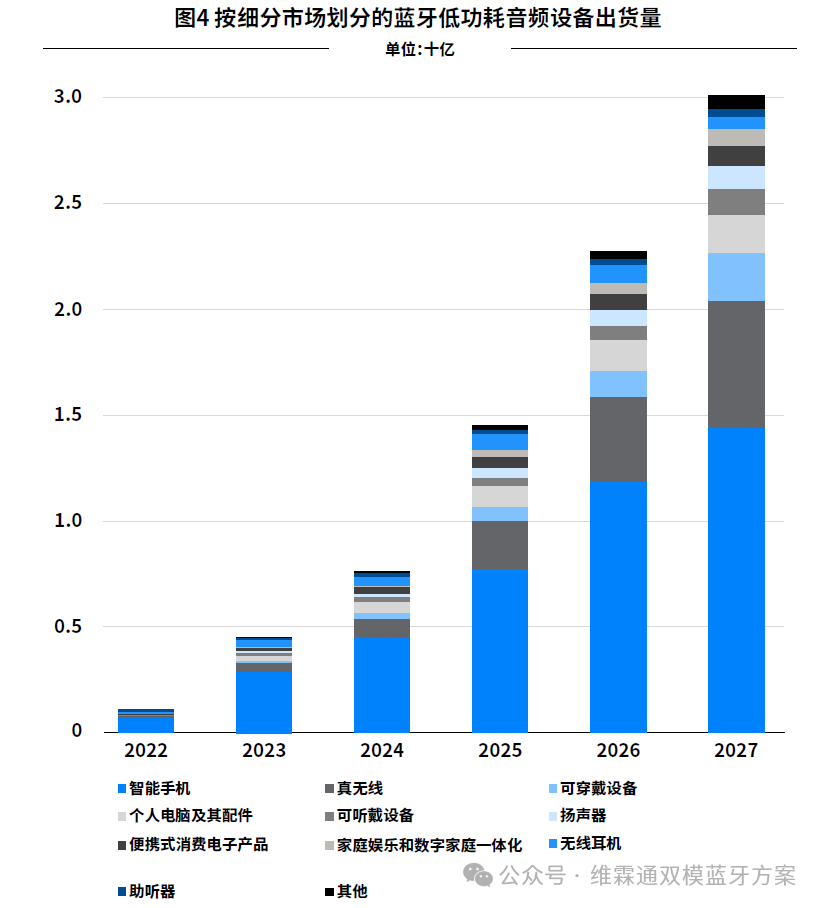
Auracast™ Broadcast Audio Brings New Business Opportunities
Undoubtedly, one of the most important new features brought by low energy audio is Auracast™ broadcast audio. With the broadcasting capabilities of low energy audio, audio transmitters can broadcast one or more audio streams to an unlimited number of Auracast™ receivers (such as headphones and hearing aids). This will help create new ways to interact with our surroundings, improve visitor experiences, and provide scalable hearing solutions. These solutions will ultimately replace existing devices and open up greater accessibility for the hearing impaired.
Auracast™ broadcast audio will bring enormous opportunities: this technology will be applied in numerous public venues, including conference and lecture halls, theaters and cinemas, airports and transportation hubs, museums, places of worship, and ultimately deployed in services environments like retail in a one-to-one manner. According to the World Health Organization, over 1.5 billion people (nearly 20% of the population) worldwide have hearing loss. This number is expected to grow to 2.5 billion by as early as 2050. Low energy audio has the potential to greatly enhance and complement existing hearing solutions and extend Auracast™ broadcast audio to many new locations and regions where hearing infrastructure is currently limited or nonexistent.
Auracast™ Broadcast Audio Use Cases
As shown in Table 1 below, the Bluetooth Special Interest Group has identified five main initial Auracast™ broadcast audio use cases. As the market develops and the installation numbers of Auracast™ broadcast audio devices increase, it is likely that other attractive new use cases will emerge.
| Use Case | Description |
| Enhanced/Aided Hearing Use Cases in Public Places | The “flagship” use case for Auracast™ broadcast audio is:As a cost-effective enhancement and aided hearing technology applied in places where public address (PA) or hearing loop infrastructure is currently deployed.With the disconnected broadcasting capabilities of low energy audio, countless users will be able to effectively listen to various audio streams in public places using personal devices. |
| Multilingual Support | Locations supporting simultaneous interpretation services can use Auracast™ broadcast audio as a multilingual technology, which is a branch of public space use cases.Users will be able to choose corresponding audio streams in their preferred language to receive information and audio.Typical use cases in this area include conference centers or cinemas. |
| Tour Systems | Another potential use case is somewhat niche—enabling users to join audio tour systems in places like museums, stadiums, conference centers, and tourist attractions.Guides will be equipped with a low energy audio broadcasting transmitter, and audiences will be able to listen to audio using their own headphones or hearing aids. |
| Mute TV Screens | Low energy audio can also be used in many locations that have TVs installed but do not provide audio or where the audio is difficult to hear, in addition to being used for audio transmission at home.With low energy audio, users can access the audio of specific screens through their Auracast™ assistant and headphone devices, thereby optimizing visitor experiences in these environments and enhancing customer satisfaction. |
| Public Counters/One-on-One Hearing | A larger and more long-term opportunity brought by low energy audio will be one-on-one or counter hearing applications.Currently, hearing loop solutions are used at various public service counters or reception desks.However, low energy audio has primarily been used for large-scale broadcasting applications, rather than private one-on-one solutions.Therefore, it may take several more years to provide a significant number of such solutions. |
Auracast™ Broadcast Audio Market Forecast
As low energy audio and Auracast™ broadcast audio are still in the development phase, it is still early to make specific predictions about the industry’s adoption of low energy audio on transmitter and receiver devices, as well as the speed of deploying Auracast™ broadcast audio in public places and other business use cases. The rollout speed of low energy audio solutions in audio source and receiver devices will directly impact the deployment of Auracast™ broadcast audio solutions in public spaces. As the installation numbers of low energy audio source and receiver devices increase, the opportunities to deploy Auracast™ broadcast audio solutions will also grow.
Understanding the potential target market for Auracast™ broadcast audio, ABI Research has determined the global venue market size based on regional venue models and the expected adoption of Auracast™ broadcast audio in different use cases, and developed a forecasting model based on that size. This model considers expected penetration rates in different regions, different timelines for various use cases, and determines the number of transmitters per deployment based on building size and the potential number of buildings/rooms in each venue. According to ABI Research statistics, there are over 61 million venues worldwide that can utilize Auracast™ broadcast audio.
As the number of new buildings increases, this figure is expected to grow to 64 million by 2030. However, as shown in Figure 4, the development of the low energy audio source and receiver device ecosystem will take some time. ABI Research expects a major turning point to occur around 2025, after which there will be additional incentives encouraging venues to begin deploying Auracast™ broadcast audio. By then, venues will be more familiar with this technology, transmitter devices will be easier to obtain, and the installation numbers of devices supporting low energy audio will reach a critical mass. Therefore, ABI Research predicts that the deployment speed of Auracast™ broadcast audio solutions will accelerate over the next decade.
Conclusion
To ensure the success of low energy audio and Auracast™ broadcast audio, several milestones need to be achieved. First and foremost, it is necessary to popularize hardware supporting Bluetooth Core Specification version 5.2 and above in the market. In terms of audio source devices, as most smartphones, tablets, and personal computer platforms are expected to support this technology in the coming years, this goal is anticipated to be achieved relatively quickly. However, the installation base for low energy audio devices will take some time to grow, and dual-mode Bluetooth Classic/low energy audio solutions will be necessary during this transition to ensure compatibility with existing devices while seizing new opportunities in the low energy audio field.
Existing companies in the audio field will maximize the utilization of their existing products and integrate low energy audio features through dual-mode solutions, while companies without existing market share can capture portions of the audio market through innovative product designs driven by the key features of low energy audio. Due to the inherently lower power consumption of low energy audio, it can be used to improve true wireless stereo headphones and hearing devices. An increasing number of independent low energy audio devices will emerge, bringing innovative user experiences and new Bluetooth audio use cases.
Regarding Auracast™ broadcast audio, extensive publicity and education will be needed to encourage venues to adopt Auracast™ broadcast audio as an auxiliary and enhanced hearing technology. Given that the number of consumer devices supporting low energy audio is significantly higher than that of hearing aids, mainstream use cases such as mute TVs, multilingual support, and other enhanced audio experiences can be promoted initially to help drive early adoption. Additionally, an ecosystem of system integrators and installers needs to be established to promote Auracast™ broadcast audio solutions in more public venues. This will also help provide a consistent user experience across various types of venues.
In terms of regulation, efforts are still needed to encourage various public venues or new venues to adopt Auracast™ broadcast audio as the primary standard hearing technology. For Auracast™ broadcast audio to become a successful technology, intuitive user interfaces need to be developed for it, and it must seamlessly integrate with existing technologies. This is particularly important for one-on-one use cases, where safety and privacy are crucial.
Finally, low energy audio should be positioned as an evolution and enhancement of current Bluetooth audio capabilities, rather than a replacement. This will help establish new use cases and consumer experiences, open the audio ecosystem to new industry participants, and elevate the Bluetooth audio market to new heights.
Wi-Link welcomes all customers and partners to contact us for inquiries! At the same time, Wi-Link has launched the Wi-Link Enterprise WeChat Direct Line, which allows direct communication with Wi-Link’s core resources, enabling timely and fast support and feedback!Wi-Link Enterprise WeChat Direct Line can directly reach Wi-Link management:
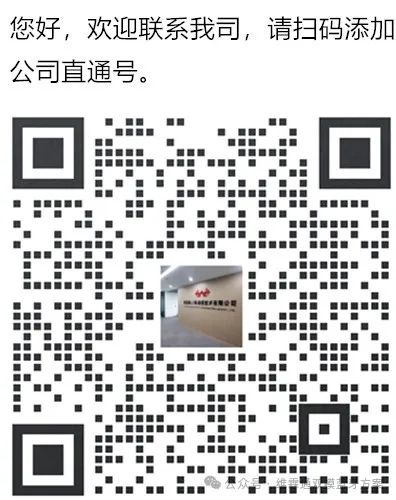
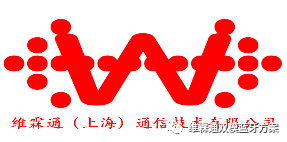 Wi-Link (Shanghai) Communication Technology Co., Ltd.was established in 2011 and has been focusing on connection solutions for short-range wireless communication technology in the Internet of Things. The company’s R&D is distributed in the Zhangjiang Hi-Tech Park in Pudong, Shanghai, and the Xinqiao Hi-Tech Development Zone in Nanjing. The company has independent intellectual property rights for Bluetooth dual-mode protocol stacks, focusing on providing globally leading dual-mode Bluetooth, BLE, WiFi, artificial intelligence voice devices, and more solutions, offering proprietary communication chips, communication modules, communication boards, communication protocol software, mobile apps, cloud computing services, etc. The company mainly serves medium and large clients in industries such as industrial IoT, automotive, medical and fitness, financial payment and security, high-end consumer electronics, professional instruments, and office equipment. More than 60 leading brands in various industries have been shipped for over five years, covering regions such as China, the United States, Europe, South Korea, and Japan, along with over 200 other medium and large domestic and foreign clients in close cooperation. The company adheres to the philosophy of people-oriented, integrity, responsibility, and innovation, committed to becoming a high-tech company with talent and technology as core competitiveness, continuous innovation, and sustainable development, emphasizing sustainable win-win cooperation with customers, deeply customizing the company’s wireless connection technology with customer industry applications, and providing long-term reliable wireless connection technology support for medium and large customers in the IoT era.
Wi-Link (Shanghai) Communication Technology Co., Ltd.was established in 2011 and has been focusing on connection solutions for short-range wireless communication technology in the Internet of Things. The company’s R&D is distributed in the Zhangjiang Hi-Tech Park in Pudong, Shanghai, and the Xinqiao Hi-Tech Development Zone in Nanjing. The company has independent intellectual property rights for Bluetooth dual-mode protocol stacks, focusing on providing globally leading dual-mode Bluetooth, BLE, WiFi, artificial intelligence voice devices, and more solutions, offering proprietary communication chips, communication modules, communication boards, communication protocol software, mobile apps, cloud computing services, etc. The company mainly serves medium and large clients in industries such as industrial IoT, automotive, medical and fitness, financial payment and security, high-end consumer electronics, professional instruments, and office equipment. More than 60 leading brands in various industries have been shipped for over five years, covering regions such as China, the United States, Europe, South Korea, and Japan, along with over 200 other medium and large domestic and foreign clients in close cooperation. The company adheres to the philosophy of people-oriented, integrity, responsibility, and innovation, committed to becoming a high-tech company with talent and technology as core competitiveness, continuous innovation, and sustainable development, emphasizing sustainable win-win cooperation with customers, deeply customizing the company’s wireless connection technology with customer industry applications, and providing long-term reliable wireless connection technology support for medium and large customers in the IoT era.
For any feedback or questions, please feel free to contact us for communication!
Company website: http://www.wi-linktech.com
Company email: [email protected]